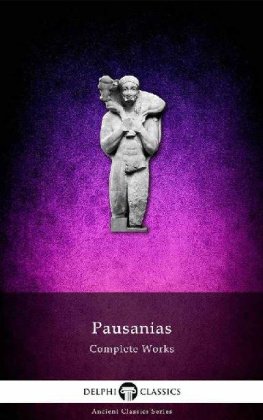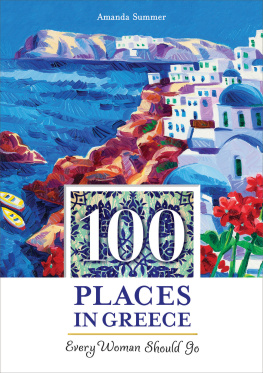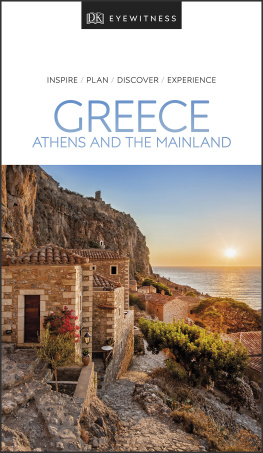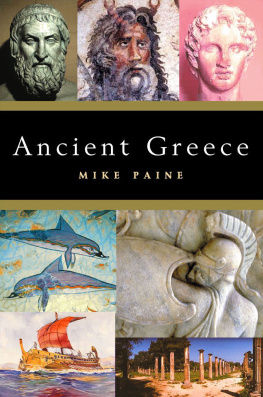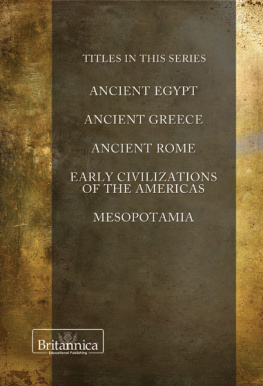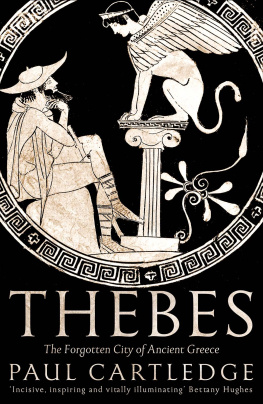
GUIDE TO GREECE
Volume I
ADVISORY EDITOR: BETTY RADICE
P AUSANIAS was a doctor from Greek Asia Minor who devoted ten or twenty years to travelling in mainland Greece during and after the reign of Hadrian, in the brief golden age of the Roman Empire (second century A.D.). It was during this time that he wrote a detailed account of every Greek city and sanctuary with historical introductions and a record of local customs and beliefs.
P ETER L EVI , a classical scholar, archaeologist and poet, was born in 1931. He translated The Psalms for the Penguin Classics, as well as a collection of Yevtushenko (with R. Milner-Gulland) for the Penguin Modern Poets. He edited The Penguin Book of English Christian Verse and, for the Penguin Classics, Johnsons A Journey to the Western Islands of Scotland and Boswells The Journal of a Tour to the Hebrides. The Light Garden of the Angel King, an account of his travels in Afghanistan, is published in the Penguin Travel Library and he is also the author of The Penguin History of Greek Literature. Peter Levi was Professor of Poetry at the University of Oxford from 1984 to 1989. He died in February 2000.
PAUSANIAS
Guide to Greece
VOLUME I
Central Greece
Translated with an Introduction by
PETER LEVI
Illustrated with drawings from Greek coins by
J OHN NEWBERRY
Maps and plans by
J EFFERY LACEY
PENGUIN BOOKS
PENGUIN BOOKS
Published by the Penguin Group
Penguin Books Ltd, 80 Strand, London WC2R 0RL, England
Penguin Group (USA) Inc., 375 Hudson Street, New York, New York 10014, USA
Penguin Books Australia Ltd, 250 Camberwell Road, Camberwell, Victoria 3124, Australia
Penguin Books Canada Ltd, 10 Alcorn Avenue, Toronto, Ontario, Canada, M4V 3B2
Penguin Books India (P) Ltd, 11 Community Centre, Panchsheel Park, New Delhi 110 017, India
Penguin Group (NZ), cnr Airborne and Rosedale Roads, Albany, Auckland 1310, New Zealand
Penguin Books (South Africa) (Pty) Ltd, 24 Sturdee Avenue, Rosebank, 2196, South Africa
Penguin Books Ltd, Registered Offices: 80 Strand, London, WC2R 0RL, England
www.penguin.com
This translation first published 1971
Reprinted with revisions 1979
Copyright Peter Levi, 1971
Coin drawings copyright John Newberry, 1971
All rights reserved
Except in the United States of America, this book is sold subject to the condition that it shall not, by way of trade or otherwise, be lent, re-sold, hired out, or otherwise circulated without the publishers prior consent in any form of binding or cover other than that in which it is published and without a similar condition including this condition being imposed on the subsequent purchaser
ISBN: 978-0-14-196312-9
FOR
NANCY SANDARS
Quomodo obscuratum est aurum, mutatus est color optimus, dispersi sunt lapides sanctuarii in capite omnium platearum?
Lamentations of Jeremiah4, 1
The work of which this is a translation was conceived in an age of dictatorship and false enlightenment, but is impregnated with that sense of a persistent religion, of the inevitable victories of reason, and of the godlike resurrections of liberty and democracy in Greece which make Greek stones noble.
LIST OF FIGURES
.
.
.
.
.
.
.
.
.
.
.
, Smyrna.
, coin of Erythrai.
.
.
.
.
.
.
.
.
.
.
LIST OF MAPS AND PLANS
MAPS
PLANS
ACKNOWLEDGEMENTS
Any commentary on Pausanias, even the thinnest, must rest on a huge structure of other peoples knowledge; no one could possibly be his own expert in everything Pausanias talked about. It is inevitable that in some field or other, perhaps in many, one will have missed important recent or old contributions to the understanding of what Pausanias wrote. If I have made mistakes of this kind (as I am bound to have done) I would be most grateful to hear of them, and in the cause of public utility to correct them either in a future edition of this book or at least in a much fuller commentary on which I am now working.
I would like to thank friends and colleagues for tolerance and for assistance. I owe more than I can express to the kindness and encouragement of Professor E. R. Dodds and Professor Eduard Fraenkel. Without their blessing I should not have undertaken this or any other work on a classical author. This book owes its existence also to the friendly interest of Professor Martin Robertson and Mr John Boardman, and most of all to the delightful and inspiring conversation and sympathetic friendship of Miss Nancy Sandars.
It is hard to know how to thank ones friends whom one feels one ought always to be thanking, but over this book I do owe particular thanks to Mr John Newberry for his drawings, to Mr Philip Sherrard and to Canon Francis Bartlett, to Mr Cyril Connolly, Mr and Mrs Watson, Mr George Pavlopoulos, Mr Takis Loumiotis, and to Sir Maurice Bowra. Within the charmed circle of Campion Hall, links are too close for thanks to be permitted. Finally I should like to express my sincere thanks to the members of the British School of Archaeology in Athens in 19657 for many constant pleasures and for constant and most practical help and advice, particularly to Mr Geoffrey Waywell, Miss Jeffery and Lord William Taylour.
Campion Hall, Oxford September 1966
CORRECTIONS
These corrections, which recent work has made necessary, are referred to in footnotes to the text.
1. The Kings Colonnade and the Colonnade of Zeus were believed until 1970 to be identical, since Pausanias had seemed to name one not two, and since the Colonnade of Zeus, which was found at the north-west corner of the Agora site, with one end chopped off by the railway, seemed to leave no room for another building. But now that the Kings Colonnade has been found, it becomes likely that Pausaniass second colonnade, behind Zeus and Hadrian, is the Colonnade of Zeus. It is possible that he leaves out its old name simply because it had been, as we know, re-adapted for the worship of the Roman emperors. Here Sokrates used to sit, and, since preliminary hearings for judgement at the Areopagos could take place here, this might be where St Paul makes his famous speech in the Acts of the Apostles. For a rigorous discussion of what evidence there is, cf. T. D. Barnes, in Journal of Theological Studies, 1969, .
2. Stories of battles between companies of three hundred are rather suspect. Just as the holding of Thermopylai against the Gauls is a literary as much as an actual reflection of the battle with the Persians, and just as the story of the Gaulish defeat at Delphi is based on a Persian wars story, forces of three hundred relate suspiciously closely to the force at Thermopylai under Leonidas. The Roman story of the three hundred Fabii all but one of whom were killed belongs to the same group (one of the earliest Roman historians was a Fabius who wrote in Greek). It is as hard to sort out the real events from the form in which we are told about them as it is to sort out the development of an epic. Can there have been a saga of three hundred dead heroes before Thermopylai?
3. There was or had once been something to see. On a tributary of the Inachos above Argos called the Kephisos (Aelian, Var. hist. 2, 33, and Strabo 9, 16, Meinekes footnote), there was a sanctuary of Aphrodite , 10 (5)).
4. LIGOURIO and its whole area are rich in antiquities; Asklepios is called Ligeotes in an inscription, and this could possibly refer to the ancient name of a site at



